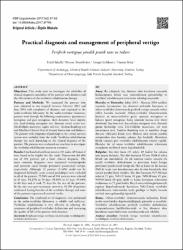| dc.contributor.author | Sakallı, Erdal | |
| dc.contributor.author | Temirbekov, Dastan | |
| dc.contributor.author | Çelikyurt, Cengiz | |
| dc.contributor.author | Kılıç, Gamze | |
| dc.date.accessioned | 2019-05-21T08:29:16Z | |
| dc.date.available | 2019-05-21T08:29:16Z | |
| dc.date.issued | 2017 | |
| dc.identifier.issn | 2587-0408 | |
| dc.identifier.uri | http://hdl.handle.net/11363/1269 | |
| dc.description.abstract | Objectives: This study aims to investigate the reliability of clinical diagnostic modalities of the patients with dizziness and the effectiveness of the vestibular rehabilitation therapy. Patients and Methods: We examined the patients who were admitted to our hospital between February 2013 and June 2014 with complaints of dizziness and examined in the audio-vestibular laboratory. In the audio-vestibular laboratory, patients went through the following examinations: spontaneous nystagmus and gaze nystagmus, skew deviation, head impulse test, head-shaking nystagmus test, dynamic visual acuity test, Dix-Hallpike maneuver, supine roll test, Tandem Romberg test and Modified Clinical Test of Sensory Interaction and Balance. The patients with symptoms of pathology in the central nervous system were excluded from the study. Vestibular rehabilitation therapy was used depending on the clinical diagnosis of the patients. The patients were evaluated one year later to investigate the vestibular rehabilitation treatment outcomes. Results: One hundred and four patients (35 males, 69 females) were found to be eligible for this study. Ninety-two (88.4%) out of 104 patients got a final clinical diagnosis. The most common diagnoses were unilateral vestibulopathy and posterior canal benign positional paroxysmal vertigo, respectively. Although 12 patients (11.6%) could not be diagnosed definitely, acute central pathologies were excluded in all of the patients. 75.96% out of 104 patients were relieved in 15 days, 94.23% in 30 days, 98.08% in 45 days, 99.04% in 60 days and it took 75 days for the rest of the patients. In the one year post-treatment interview, 83.2% of patients confirmed having benefits of the vestibular therapy and none of the patients experienced cerebral stroke. Conclusion: The combined set of diagnostic tests performed in the audio-vestibular laboratory is reliable and sufficient. Vestibular rehabilitation is very effective in relieving the symptoms of peripheral vestibular dysfunction and increasing the quality of life of the patients with dizziness. Keywords: Peripheral vertigo; vestibular rehabilitation; vestibulopathy; vestibular dysfunction. | en_US |
| dc.description.abstract | Amaç: Bu çalışmada baş dönmesi olan hastaların tanısında kullandığımız klinik tanı yöntemlerinin güvenilirliği ve vestibüler rehabilitasyon tedavisinin etkinliği araştırıldı. Hastalar ve Yöntemler: Şubat 2013 - Haziran 2014 tarihleri arasında hastanemize baş dönmesi nedeniyle başvuran ve odiyo-vestibüler laboratuvarda periferik vertigo tanısıyla tedavi edilen hastalar incelendi. Odiyo-vestibüler laboratuvarında hastalar şu muayenelerden geçti: spontan nistagmus ve bakışta (gaze) nistagmus, bakış yönünde kayma testi (skew deviation), baş itme testi, baş sallama nistagmus testi, dinamik görme keskinliği testi, Dix-Hallpike manevrası, sırt üstü yuvarlanma testi, Tandem Romberg testi ve modifiye denge duyusal etkileşimi klinik testi. Merkezi sinir sistemi patoloji semptomları olan hastalar çalışma dışı bırakıldı. Hastaların klinik tanısına göre vestibüler rehabilitasyon tedavisi yapıldı. Hastalar bir yıl sonra vestibüler rehabilitasyon tedavisinin sonuçlarını incelemek üzere değerlendirildi. Bulgular: Yüz dört hasta (35 erkek, 69 kadın) bu çalışma için uygun bulundu. Yüz dört hastanın 92’sine (%88.4) nihai klinik tanı konulabildi. En sık konulan tanılar sırasıyla tek taraflı vestibüler disfonksiyon ve posteriyor kanal benign pozisyonel paroksizmal vertigo idi. Her ne kadar on iki hastaya (%11.6) kesin tanı konulamamış olsa da tüm hastalarda akut santral patoloji hariç tutuldu. Yüz dört hastanın %75.96’sının tedavisi 15 gün, %94.23’ünün 30 gün, %98.08’inin 45 gün, %99.04’ünün 60 gün sürdü ve kalan hastaların tedavisinin sonlanması ise 75 günü buldu. Bir yıl sonra telefon görüşmesiyle yapılan değerlendirmede hastaların %83.2’sinin vestibüler rehabilitasyon tedavisinden fayda gördüğü ve hiçbir hastada serebral inme gelişmediği öğrenildi. Sonuç: Odiyo-vestibüler laboratuvarında kullanılan klinik testler serisi birlikte değerlendirildiğinde güvenilir ve yeterlidir. Vestibüler rehabilitasyon, periferik vestibüler disfonksiyon semptomlarının hafifletilmesinde ve baş dönmesi olan hastaların yaşam kalitesinin artırılmasında çok etkilidir. Anahtar sözcükler: Periferik vertigo; vestibüler rehabilitasyon; vestibülopati; vestibüler disfonksiyon. | en_US |
| dc.language.iso | eng | en_US |
| dc.publisher | İstanbul KBB-BBC Uzmanları Derneği | en_US |
| dc.relation.isversionof | 10.5606/kbbu.2017.97769 | en_US |
| dc.rights | info:eu-repo/semantics/openAccess | en_US |
| dc.rights | Attribution-NonCommercial-NoDerivs 3.0 United States | * |
| dc.rights.uri | http://creativecommons.org/licenses/by-nc-nd/3.0/us/ | * |
| dc.subject | Research Subject Categories::MEDICINE | en_US |
| dc.title | Practical Diagnosis and Management of Peripheral Vertigo | en_US |
| dc.title.alternative | Periferik Vertigoya Yönelik Pratik Tanı ve Tedavi | en_US |
| dc.type | article | en_US |
| dc.relation.ispartof | Kulak Burun Boğaz Uygulamaları | en_US |
| dc.department | Sağlık Bilimleri Yüksekokulu | en_US |
| dc.identifier.volume | 5 | en_US |
| dc.identifier.issue | 2 | en_US |
| dc.identifier.startpage | 57 | en_US |
| dc.identifier.endpage | 62 | en_US |
| dc.relation.publicationcategory | Diğer | en_US |



















